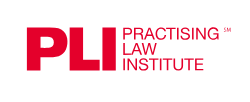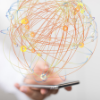Quarterly Journal Volume 52, Issue 3
In This Section
The Quarterly Journal is dedicated to presenting materials relating to intellectual property matters and is published four times per year. Editorial Board members (all of whom are lawyers) are selected based upon demonstrated interest and experience, and student staff members are selected from the students of the GWU Law School.
Thank you to our issue sponsor!

 QJ 52.3 - Auctorem Ex Machina: A Case For Human Copyright Authorship in Works Created Using Generative Artificial Intelligence
QJ 52.3 - Auctorem Ex Machina: A Case For Human Copyright Authorship in Works Created Using Generative Artificial Intelligence
Jake L. Bryant
Ours is an era of artificial relationships, an age where man is as connected to the machine as he is to other people. Recent developments in deep learning technology have posed a significant question to copyright jurisprudence: are works created using generative artificial intelligence (AI) the product of an author under copyright law? In this article, I examine the nature of generative AI models, the differences between large language models (LLMs) and large visual models (LVMs), and the history of authorship in U.S. copyright law before proposing a general test for authorship and qualifying prompt engineers as authors of certain works created using generative AI. The ultimate test for authorship must consider two factors derived from historical precedent. This test first asks whether the underlying work, in the event human authorship exists, meets the Feist standard of originality. The second factor considers the copyright claimant’s creative control over the conception, whether the work is a reasonable manifestation of the putative author’s intent. When a work is created using marginally supervised automated processes and contains subject matter not staged by the putative author, the determinative question is whether the copyright claimant’s creative inputs establish a limited universe of foreseeable results. In the case of visual works created with generative AI, courts can look to (1) the level of specificity and detail in the prompt text; (2) whether any additional parameters are used; (3) any use of job seeding to control the starting point of the image diffusion process; (4) the use of variation or regional variation buttons in creating the final image; (5) and the similarity of the final image to the prompt description as creative inputs to be considered in determining authorial control. Not every image created using generative AI will pass muster. If the prompt used is so abstract and lacking in additional parameters such that it amounts to little more than an idea, then demonstrating that the putative author’s intent was to generate an image substantially encapsulating the elements of the final chosen work is near impossible. However, many works generated according to highly specific, detailed prompts merit copyright protection.
 QJ 52.3 - Solutions to the Problem of Therapeutic Antibody Genus Claims
QJ 52.3 - Solutions to the Problem of Therapeutic Antibody Genus Claims
Jorge Goldstein PhD, JD
Court interpretations of the enablement and written description requirements of 35 U.S.C. § 112(a) have led to the erosion of legal support for the patentability and survival of genus claims for therapeutic antibodies and their uses. Most recently, the Federal Circuit in Amgen v. Sanofi (2021) applied a trio of chemical molecule precedents, Wyeth v. Abbott (2013), Enzo Life Sciences v. Roche (2019), and Idenix v. Gilead (2019) to deny enablement of a genus of antibodies claimed in quasi-chemical format. In affirming the Amgen decision in 2023, the Supreme Court added a “common quality” requirement for enablement of such claims. Analysis of claim requirements shows that, in most instances when the Federal Circuit has evaluated a genus claim to an antibody per se having blocking or biological requirements or to a method of therapy using such antibody, the Court held that such claim lacked either full scope enablement or full scope written description. This Article evaluates and proposes several solutions for the difficult task of obtaining and defending antibody genus claims. When a new target is discovered –that is, the target is unknown– and a novel antibody is generated against it, it should be possible under Chiron v. Genentech (2004) to put forth a per se antibody genus claim with no requirements other than a simple binding definition. Even if the target is known and the invention is that blocking such target leads to a heretofore unbeknownst method of therapy then, following the format in Hopkins v. CellPro (1998), an antibody genus can be claimed in per se form by a binding definition plus a competitive binding requirement relative to a specifically identified reference antibody. Such a claim is akin to an immunoassay claim, which under In re Wands (1988) and Hopkins, is more readily enabled and described than a claim with blocking or biological requirements. This is particularly the case when using today’s state of the art high-throughput screening immunoassays enhanced by AI. Other promising formats, such as means plus function claims are also evaluated.
 QJ 52.3 - Infringement Notice on Related Corporations: A Requirement of Patent Law Caught in the Jaws of State Law
QJ 52.3 - Infringement Notice on Related Corporations: A Requirement of Patent Law Caught in the Jaws of State Law
Immanuel J. Elijah
Patent law has been universally treated as a body of law exclusively under the federal scheme. Yet there are situations in patent law where state law will breach this federal exclusivity. One such breach occurs when a party seeks presuit damages from a corporation in a parent-subsidiary relationship with another. If a patentee wants to pursue such damages against these related corporations, corporate law regulates whether presuit notice will impute knowledge and liability onto the related corporation. In this way, corporate law controls who the patentee may receive damages from. This Note addresses how involving state corporate law risks creating inconsistencies in federal patent law, contradictory to preemption standards, by dispositively impacting how presuit notice imputes knowledge and liability on related corporations. To resolve these issues, this Note proposes an interpretive approach using preemption standards, considering constitutional and congressional interests in exclusive federal control over patent law, the patent-specific nature of presuit notice, and the preexisting formulations of agency law. The Federal Circuit should set a universal standard.
 QJ 52.3 - Ghostwriters and State Legislatures: Copyright and Access to the Law
QJ 52.3 - Ghostwriters and State Legislatures: Copyright and Access to the Law
Shalom Samuels
Upcoming Events
-
.png?sfvrsn=9aa26827_1) 2026 AIPLA Virtual Corporate Practice Institute
2026 AIPLA Virtual Corporate Practice Institute
January 13 to 20, 2026 | Up to 360 Minutes of CLE
The Corporate Practice Institute is not a bootcamp. This program provides in-depth insight for in-house corporate counsel and agents to learn about wide ranging legal issues affecting their practice from experienced practitioners. It is designed for experienced in-house attorneys and new in-house attorneys learning to manage new corporate environments and challenges not taught in law schools or private practice. The Institute also helps private practice attorneys, especially associates, prepare for potential in-house career moves. The program also provides valuable networking opportunities to connect with each other and learn from each other's experiences. This online, CLE-program spans two half-days, from Noon – 5:00 pm Eastern and includes 3 one-hour education sessions and a networking session each day. -
.png?sfvrsn=fb5905da_1) 2026 IP Transactions Bootcamp
2026 IP Transactions Bootcamp
February 12, 2026
This in-person-only bootcamp is designed to provide practical insights and strategies for professionals working in intellectual property transactions. The day features a comprehensive agenda including: Panels and CLE Sessions: Learn about Working with Tech Transfer Offices, Strategies for successful collaborations between nonprofits and industry, and Protecting and monetizing an AI asset. Drafting and Negotiating Tips: Get practical advice on drafting and negotiating strategic collaboration and license agreements. Hands-on Workshop: Participate in a Mock licensing negotiation to put your skills to the test. Networking: Conclude the day with a dedicated Networking reception. Registration Coming Soon! -
-(1).png?sfvrsn=7a1054_1) 2026 Trade Secret Summit
2026 Trade Secret Summit
March 26 to 27, 2026
The AIPLA Trade Secret Summit is the leading trade secret conference in the nation, with speakers from across the spectrum of private practitioners, in-house counsel, government, and academia, as well as fantastic networking opportunities. CLE credits will be available. -
2025 Women in IP Global Networking Event
April 16, 2026
-
2026 Spring Meeting - San Francisco, CA
May 13 to 15, 2026
We’re excited to welcome you to the 2026 AIPLA Spring Meeting, where innovation, technology, and intellectual property come together to shape the future. San Francisco is ready for your ideas, energy, and passion for IP!

